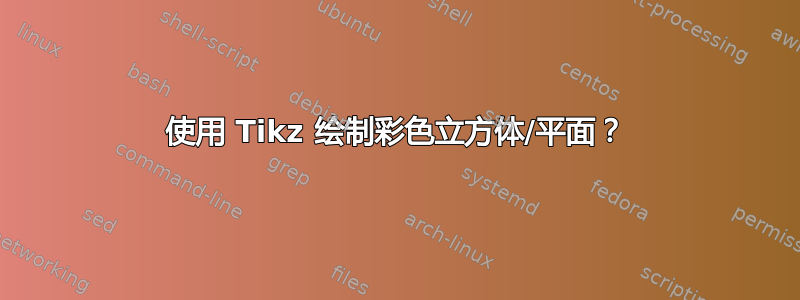
答案1
您的版本几乎已经完成,恭喜。我使用了您的一些作品,并添加了一些我自己的作品。
\documentclass[tikz,border=3.141592mm]{standalone}
\usetikzlibrary{arrows.meta}
\usepackage{newtxtext,newtxmath}
\newcommand{\defclr}{
\pgfmathsetmacro\wavelen{\wavemax-(\wavemax-\wavemin)*\i/\t}
\definecolor{clr}{wave}{\wavelen}}
\begin{document}
\begin{tikzpicture}[
>=Stealth,
every node/.style={scale=1.5},
x={(0.19 cm,0.16 cm)},
y={(0 cm,1 cm)},
z={(1 cm,0 cm)}
]
\draw [->] (-1,0,0) -- (40,0,0) node [at end, above] {$\lambda$};
\draw [->] (0,-1,0) -- (0,6,0) node [at end, left] {$y$};
\draw [->] (0,0,-1) -- (0,0,20) node [at end, above] {$z$};
\def\t{18} \def\op{0.6}
\def\wavemax{420} \def\wavemin{650} % obvious, isn't it?
\def\l{2.5} %length of the squares
\def\a{1} \def\b{7} \def\c{13} % z pos of the square stacks
\foreach \i in {0,9,...,\t}
{
\defclr
\fill[clr,opacity=\op] (\t-\i+3,0,\a) rectangle ++ (0,\l,\l);
}
\foreach \i in {0,3,...,\t}
{
\defclr
\fill[clr,opacity=\op] (\t-\i+3,0,\b) rectangle ++ (0,\l,\l);
}
\foreach \i in {0,0.5,...,\t}
{
\defclr
\fill[clr,opacity=\op] (\t-\i+3,0,\c) rectangle ++ (0,\l,\l);
}
\node[below=15pt] at (3,0,\a+.5*\l) {RGB};
\node[below=15pt] at (3,0,\b+.5*\l) {MSI};
\node[below=15pt] at (3,0,\c+.5*\l) {HSI};
\end{tikzpicture}
\end{document}
编辑
我搜索了一种方法,为方块添加漂亮的纹理,就像原始图片中那样,但找不到任何方法(欢迎在评论中提出任何建议)。但我认为添加一些模糊阴影来给这张图片增添一点活力是个好主意。所以这是第二个版本,有一些调整和阴影。
\documentclass[tikz,border=3.141592mm]{standalone}
\usetikzlibrary{arrows.meta,shadows.blur}
\usepackage{newtxtext,newtxmath}
\newcommand{\defclr}{
\pgfmathsetmacro\wavelen{\waveback-(\waveback-\wavefront)*\i/\t}
\definecolor{clr}{wave}{\wavelen}}
\tikzset{myshadow/.style={blur shadow={shadow blur steps=50,shadow blur extra rounding=3pt,shadow xshift=5pt,shadow yshift=-5pt, shadow blur radius=3pt,shadow opacity=10}}}
\begin{document}
\begin{tikzpicture}[
>={Stealth[width=8pt, length=10pt]},
every node/.style={scale=2},
x={(0.12 cm,0.11 cm)},
y={(0 cm,1 cm)},
z={(1 cm,0 cm)}
]
\draw [->] (-2,0,0) -- (48,0,0) node [at end, above] {$\lambda$};
\draw [->] (0,-.5,0) -- (0,6,0) node [at end, left] {$y$};
\draw [->] (0,0,-.5) -- (0,0,19) node [at end, above] {$x$};
\def\t{18} \def\op{0.6}
\def\waveback{440} \def\wavefront{650} % obvious, isn't it?
\def\l{2.5} %length of the squares
\def\a{1} \def\b{7} \def\c{13} % x pos of the square stacks
\foreach \i in {0,9,...,\t}
{
\defclr
\fill[myshadow,clr,opacity=\op] (\t-\i+3,0,\a) rectangle ++ (0,\l,\l);
}
\foreach \i in {0,3,...,\t}
{
\defclr
\fill[myshadow,clr,opacity=\op] (\t-\i+3,0,\b) rectangle ++ (0,\l,\l);
}
\foreach \i in {0,0.5,...,\t}
{
\defclr
\fill[myshadow,shadow opacity=5,clr,opacity=\op] (\t-\i+3,0,\c) rectangle ++ (0,\l,\l);
}
\def\dist{12pt}
\node[below=\dist] at (3,0,\a+.5*\l) {RGB};
\node[below=\dist] at (3,0,\b+.5*\l) {MSI};
\node[below=\dist] at (3,0,\c+.5*\l) {HSI};
\end{tikzpicture}
\end{document}
答案2
暂时我得到了这样的结果:
\documentclass{article}
\usepackage{tikz}
\usetikzlibrary{patterns}
\begin{document}
\def\total{15}
\newcommand{\plane}[3][fill=blue!10!white]{
\pgfmathsetmacro\wavelen{650-(650-420)*#2/\total}
\definecolor{adc}{wave}{\wavelen}
\fill[opacity=0.7,adc] (#3, 0, #2) rectangle (#3+3, 3, #2);
}
\hspace*{-4cm}%
\begin{tikzpicture}[scale=.8]
% \begin{scope}[shift={(-15,0)}]
%\coordinate (O) at (0, 0, 0);
\draw[line width=0.4mm,->] (O,0,16) --++ (16,0,0) node[anchor=north east]{$z$};
\draw[line width=0.4mm,->] (O,0,16) --++ (0,8,0) node[anchor=north east]{$y$};
\draw[line width=0.4mm,->] (O,0,16) --++ (0,0,-25) node[anchor=east]{$\lambda$};
\node[below] at (2,0,17) {RGB};
\node[below] at (7,0,17) {Multispectral};
\node[below] at (12,0,17) {Hyperspectral};
%\plane[draw=none,pattern=dots]{0};
\def\total{15}
%\foreach \x in {1,2,...,\total}
%\plane{\x};
\foreach \x in {1,7,...,\total}
\plane{\x}{0};
\foreach \x in {1,3,...,\total}
\plane{\x}{5};
\foreach \x in {1,1.5,...,\total}
\plane{\x}{10};
%\end{scope}
\end{tikzpicture}
\end{document}






